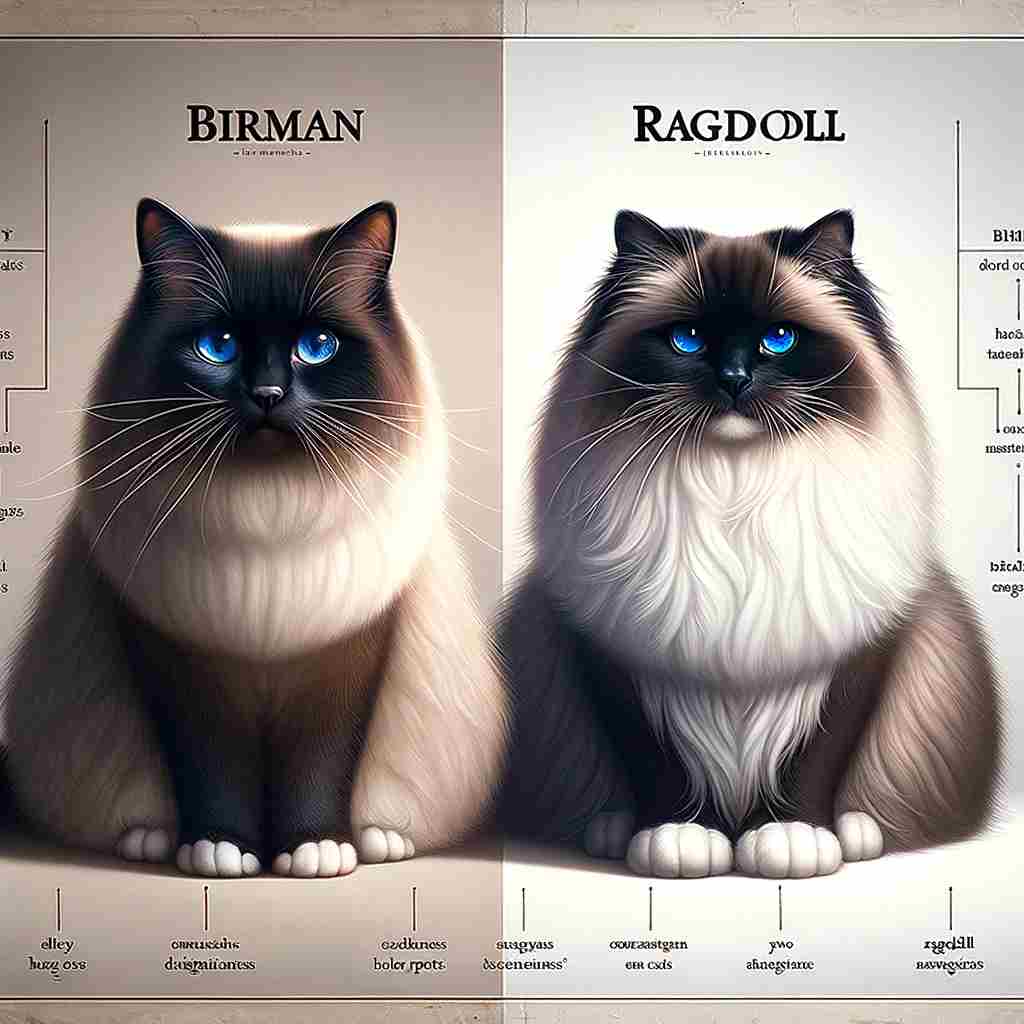In this article, we will compare and contrast the Birman vs Ragdoll cat breeds. We will delve into their unique traits, characteristics, and charms to help you make an informed decision when choosing your perfect companion.
Birman vs Ragdoll: Appearance and Size Differences
The Birman and Ragdoll breeds are known for their distinctive appearances and size differences. Understanding their coat patterns, colors, body structures, and sizes can help you differentiate between these two captivating breeds.
The Birman breed features a medium-sized body with a sturdy build, while the Ragdoll breed tends to be more substantial in size. Ragdolls are known for their muscular frame and can reach impressive weights, with males weighing anywhere from 15 to 20 pounds and females ranging between 10 to 15 pounds.
Coat-wise, both breeds have luxurious, soft fur that is a true delight to touch. Birmans have a silky texture to their medium-length coat, whereas Ragdolls have a longer and fuller coat with a plush texture. The coat colors and patterns differ between the breeds as well.
Temperament and Personality: Birman vs Ragdoll Cat
The Birman and Ragdoll cat breeds are well-known for their friendly and affectionate nature, making them popular choices for cat lovers seeking a loving and loyal companion. However, despite their similar temperaments, each breed possesses unique personality traits that set them apart.
Birman Temperament and Personality
The Birman cat breed is renowned for its sweet and gentle disposition. They are known to be calm, loving, and sociable cats that thrive on human companionship. Birmans are often described as being easygoing and adaptable, making them excellent family pets. They enjoy being involved in all aspects of their owners’ lives and are known to be attentive and affectionate towards their human family members.
Birmans are also known for their curiosity and playfulness. They enjoy interactive toys and are generally good with children and other pets. However, they are not overly demanding or attention-seeking, making them a suitable choice for households with a more relaxed and tranquil atmosphere.
Ragdoll Temperament and Personality
Like the Birman, the Ragdoll cat breed has a reputation for its loving and affectionate nature, often referred to as “puppy-like” due to their tendency to follow their owners around the house. Ragdolls are known for their laid-back and relaxed demeanor, and they often enjoy being cradled or held like a baby.
Ragdolls are famously docile and gentle, making them ideal companions for families with children or other pets. They have a strong desire to be near their human family members and will often seek out their company. Ragdolls are known for their ability to adapt well to different environments and are generally easy to handle and train.

Birman vs Ragdoll Cat Grooming and Coat Maintenance
Both the Birman and Ragdoll breeds have long, silky coats that require regular grooming to keep them healthy and looking their best. However, there are some differences in their grooming requirements, shedding levels, and grooming techniques. Let’s explore these aspects to help you determine which breed fits your lifestyle and grooming preferences.
Grooming Requirements
| Breed | Grooming Requirements |
|---|---|
| Birman | Regular brushing at least once a week to remove loose hair and prevent matting. Pay extra attention to areas prone to matting like the armpits, belly, and tail. Monthly baths may be necessary to keep the coat clean and tangle-free. |
| Ragdoll | Weekly brushing is usually sufficient to keep their coat looking its best. However, during shedding seasons, which occur twice a year, more frequent brushing may be necessary to manage the increased hair loss. Monthly baths can help keep their long fur in top condition. |
Birman cat vs Ragdoll cat Shedding
When it comes to shedding, both the Birman and Ragdoll breeds shed their fur, although the intensity and frequency may vary. Understanding their shedding patterns can help you prepare for managing the stray hairs in your home. Here’s a comparison:
- The Birman cat has a moderate shedding level throughout the year. Regular brushing can significantly reduce loose hair and minimize shedding around the house.
- The Ragdoll cat has a higher shedding level during seasonal shedding periods, which occur in the spring and fall. During these times, more frequent brushing can help keep shedding under control.
Tips for Grooming
To keep your Birman or Ragdoll’s coat looking its best, here are some grooming tips:
- Use a high-quality cat brush or comb to remove loose hair and prevent mats.
- Be gentle while grooming, especially around sensitive areas like the face and ears.
- Offer treats or rewards during grooming sessions to make it a positive experience for your cat.
- Regularly check their nails, ears, and teeth during grooming to ensure their overall health and well-being.
Intelligence and Adaptability: Who’s the Smartest?
When it comes to choosing a cat breed, intelligence and adaptability are crucial factors to consider. In this section, we will compare the Birman and Ragdoll breeds in terms of their problem-solving abilities and ease of adjustment to new environments and routines.
Intelligence
The intelligence of a cat breed can greatly impact their trainability and ability to learn new commands and tricks. Both the Birman and Ragdoll cats are intelligent breeds, but they may exhibit different levels of cognitive skills and problem-solving abilities.
Birman Cats: Birmans are known for their cleverness and quick thinking. They have a reputation for being highly observant and can quickly assess a situation. Their intelligence enables them to figure out solutions to puzzles and engage in interactive play with their owners.
Ragdoll Cats: Ragdolls are also intelligent cats, although their problem-solving skills may be different from Birmans. They are known for their laid-back nature and tend to think before taking action. While they may not be as quick to learn tricks, they are excellent at reading and responding to their owners’ emotions and providing comfort.
Adaptability
The adaptability of a cat breed determines how well they can adjust to new environments, routines, and changes in their surroundings. This is an essential quality for cats that may need to adapt to new homes or travel frequently.
Birman Cats: Birmans are generally adaptable cats and can adjust well to changes. They are known for their relaxed and sociable nature, which makes them more open to new experiences and people. Birmans thrive in households with a consistent routine and environment.
Ragdoll Cats: Ragdolls are also highly adaptable cats. They tend to be more laid-back and take changes in stride. Ragdolls are known for their gentle and affectionate nature, which makes it easier for them to adapt to new people and environments.
Health Concerns: Birmans vs Ragdolls
When considering a cat breed, it is crucial to factor in potential health issues. Both the Birman and Ragdoll breeds have their own sets of health concerns that owners should be aware of.
Birman Health Issues
The Birman breed is generally healthy, but there are a few conditions that they may be prone to:
- Gastric stasis
- Polycystic kidney disease (PKD)
- Dilated cardiomyopathy (DCM)
Regular visits to the veterinarian, a balanced diet, and exercise can help prevent and manage these health issues. It is essential to educate yourself about the signs, symptoms, and treatments for these conditions to ensure your Birman’s well-being.
Ragdoll Health Issues
Ragdolls, too, have a generally good health record, but there are a few health issues that owners should be aware of:
- Hypertrophic cardiomyopathy (HCM)
- Bladder stones
- Megaesophagus
Regular veterinary check-ups, a proper diet, and a safe environment can help prevent and manage these health conditions. Familiarize yourself with the symptoms and treatments associated with these issues to ensure your Ragdoll stays healthy and happy.
| Health Concerns | Birman | Ragdoll |
|---|---|---|
| Gastric stasis | + | – |
| Polycystic kidney disease (PKD) | + | – |
| Dilated cardiomyopathy (DCM) | + | – |
| Hypertrophic cardiomyopathy (HCM) | – | + |
| Bladder stones | – | + |
| Megaesophagus | – | + |
Conclusion
Both Birman and Ragdoll cats are beloved for their striking appearances and affectionate natures. When choosing between these two breeds, consider your lifestyle and personal preferences. If you’re looking for a more relaxed and mellow companion, a Ragdoll might be the perfect fit.
On the other hand, if you prefer a social and playful cat with a silky coat, a Birman could be your ideal feline friend. Whichever breed you choose, you’re sure to have a loving and charming companion to share your life with.
FAQs
Q: What are the key differences between Birman and Ragdoll cats?
A: While both are stunning cat breeds, Birmans and Ragdolls differ in their origins, coat patterns, and temperament. Birmans are known for their distinct color points and soulful blue eyes, whereas Ragdolls are larger and have a tendency to go limp when picked up. Additionally, Birmans tend to be more vocal compared to the gentle and easygoing nature of Ragdolls.
Q: Are Ragdoll and Birman cats suitable as companion pets?
A: Both Ragdolls and Birmans are exceptional companion cats, known for their affectionate and loyal nature. Ragdolls are renowned for their gentle and trusting personality, while Birmans are vocal and interactive, making them ideal for individuals seeking feline companionship.
Q: Can you distinguish between Ragdoll and Birman kittens from a young age?
A: While Ragdoll and Birman kittens may look similar in their early stages, there are subtle clues that can help differentiate the two. Ragdoll kittens are born entirely white and gradually develop their color points over time, while Birman kittens are born with their color points already visible. Additionally, Ragdoll kittens tend to go limp when handled, a trait not observed in young Birmans.

Hey guys, My name is Simon Smith. I’m from Canada and live near Victoria
I live with my sweet family and have 20+ Ragdolls of different types. I love them as my own children. My profession is as a hotel manager.
I love to keep Ragdolls and grow their breeder case. I have 7 years of experience.
I’m an expert in cat care. So, I’m here to provide you with new information about my cats daily. This is my personal blog website, so I request that you kindly visit our site daily.
If you’re a Ragdolls lover and you have any questions or confusion about cats, text me on the Contact Us page or Gmail.
Thank u
